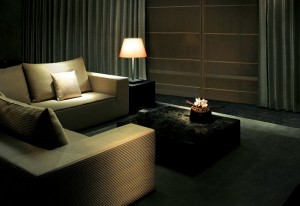By Selina Denman www.constructionweekonline.com
Dubai’s new super-scraper boasts some of the highest interior specs in the industry. David Ingham and Claire Ferris-Lay talk to those responsible for rolling them out
 The specification on the Burj Khalifa project is one of the highest that industry veteran, Talal Saeed, managing director of Fino International, has ever encountered. “The specification is one of the highest I’ve ever seen and experienced. There were so many consultants supervising and reporting to each other to make sure everything works perfectly.”
The specification on the Burj Khalifa project is one of the highest that industry veteran, Talal Saeed, managing director of Fino International, has ever encountered. “The specification is one of the highest I’ve ever seen and experienced. There were so many consultants supervising and reporting to each other to make sure everything works perfectly.”
Dubai-based interiors specialist Fino International was appointed to work on three separate areas of the world’s tallest building. The job, which is now almost complete, has taken 33 months and is worth AED400 million to Fino.
One section of the work was the tower’s public areas, including the main entry lobby, the Armani café, various restaurants, prayer areas, a health club and spa. A second part of the contract was the corporate offices and private offices of Emaar, on levels 152 to 154.
The largest part of the job was the fit-out of the Armani Residences and the Armani Hotel Dubai, which required painstaking attention to detail and close co-ordination with teams from Armani and Emaar Hotels. Materials such as marble, onyx and gypsum were sourced from countries as far wide as Canada, Pakistan and Madagascar. Those materials were shipped to Italy, where they were treated and inspected, and then sent to Dubai for cutting and water-jetting prior to installation.
A brand new type of paint, developed by Armani specifically for the Burj Khalifa project, was used throughout the Armani properties. Four coats of the paint had to be applied, with at least 24 hours of drying required between the application of each layer.
Reflecting the level of care that has gone into the building, Saeed explained that every single wall in the hotel had to be inspected and approved by SOM, the project architect, Turner, the construction project manager, and Armani. The hotel will open on March 18, while handover of apartments in Armani Residences will begin in February.
Fino International started the Burj Khalifa project with around 300 people on site, a figure that rose to around 2,500 people at peak times. Fino was also the last company to make use of the crane on level 154 of the building, which it employed to help lift large sheets of glass.
Saeed described working on Burj Khalifa as both “enlightening” and “surprising”. Striking factors were the incredible heights, the fluctuations in temperature between ground and upper levels, and the strict enforcement of health and safety procedures.
“You cannot just bring a new employee along and go inside,” said Saeed. “You have to give them a lecture on how to move around inside the building and what to do in case of fire… there were training exercises for the workers almost weekly.”
Nadim Akhrass, managing director of operations for Depa, which was contracted to fit out all of the building’s other residential apartments, also drew attention to the logistical challenges of working on the world’s tallest building.
Depa regularly works on large-scale projects such as luxury hotels, airports, cruise ships, malls and offices. But completing the Burj Khalifa, while simultaneously installing the interiors for another of Dubai’s major projects, the Metro, was undoubtedly one of its toughest tests to date.
“To move hundreds of workers up hundreds of floors to the final work location, to feed them, take care of their sanitary facilities and get them back to buses at the end of the day is a very challenging process,” Akhrass explained.
“We never expected it to be an easy project; after all, this is the world’s tallest tower and we always knew it would be challenging,” he continued. “The bright side is that the world will soon be able to see the fruits of three years of very hard work.”
Many of the problems centred around transporting thousands of tonnes of materials up to some of the tallest residential apartments in the world. Then there was dealing with the sheer size of Depa’s labourforce. While the firm had 150 staff working in the office from the beginning of the project, during the peak of construction, which continued for more than a year and a half, the firm employed more than 2,400 labourers onsite.
To overcome the time constraints, Depa ensured that all transportation of materials, which included a staggering 8,000 tonnes of marble imported from Italy, 100,000m² of parquet flooring and 8,500 timber doors, was completed at night.
Depa won the ‘S06’ contract to fit out all of the building’s residential apartments in April 2006.
As part of the mandate, the firm has completed the interiors of 900 apartments between floors 19 and 107 on the middle tiers, which are located above the Armani hotel.
Akhrass said users will be more than satisfied with the end results of the firm’s hard work. “The apartments are beautiful. While the contractors had a tough time building them, the end users will enjoy very high-end, quality apartments,” he said confidently. “When visitors get out of the lift, they won’t feel like they are in a residential building. It’s more of a high-end hotel finish.”














